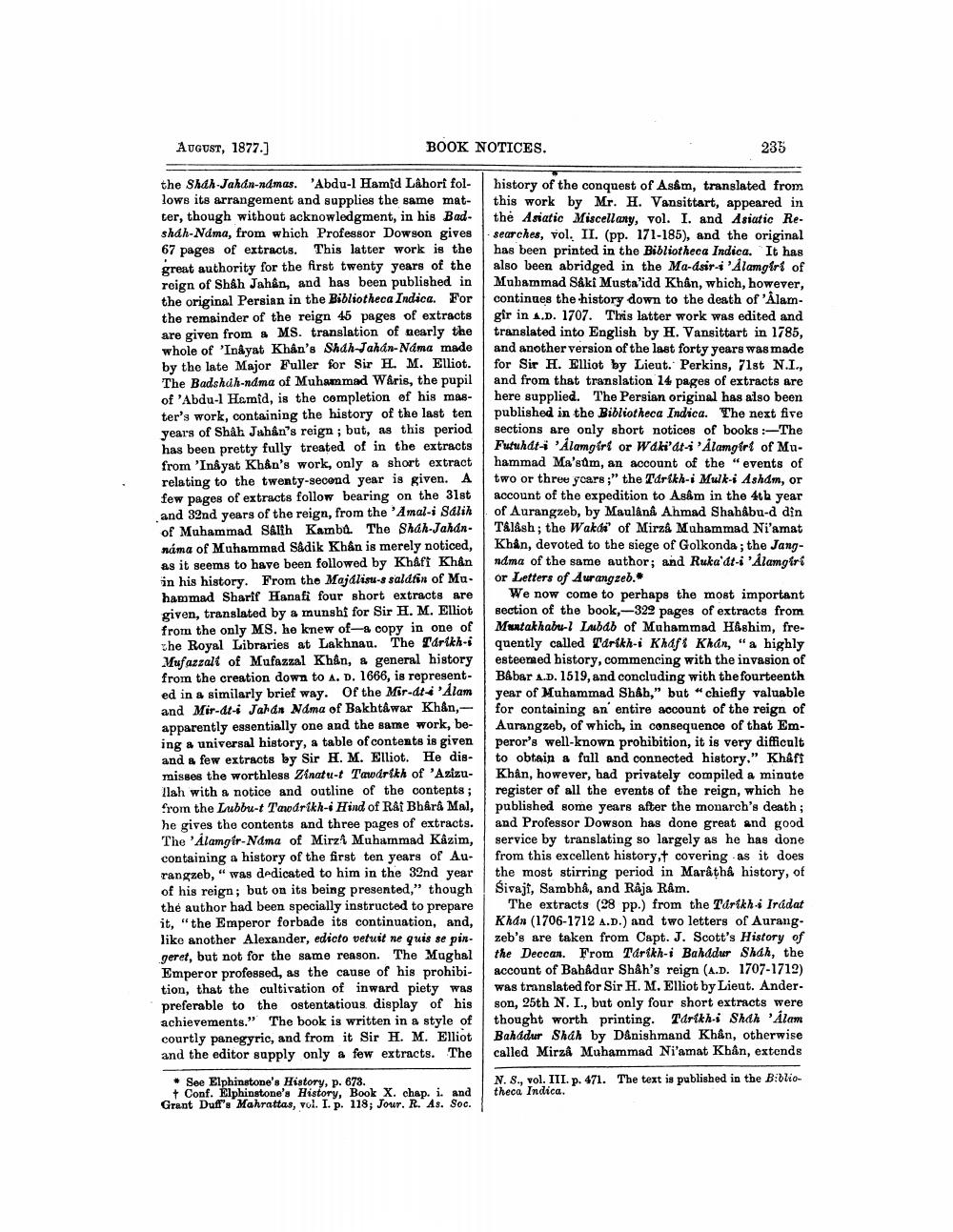________________
AUGUST, 1877.]
the Shah-Jahan-ndmas. 'Abdu-l Hamid Lahori follows its arrangement and supplies the same matter, though without acknowledgment, in his Badshah-Náma, from which Professor Dowson gives 67 pages of extracts. This latter work is the great authority for the first twenty years of the reign of Shah Jahân, and has been published in the original Persian in the Bibliotheca Indica. For the remainder of the reign 45 pages of extracts are given from a MS. translation of nearly the whole of 'Inayat Khân's Shah-Jahán-Náma made by the late Major Fuller for Sir H. M. Elliot. The Badshah-náma of Muhammad Wâris, the pupil of 'Abdu-l Hamid, is the completion of his master's work, containing the history of the last ten years of Shah Jahân's reign; but, as this period has been pretty fully treated of in the extracts from 'Inayat Khân's work, only a short extract relating to the twenty-second year is given. A few pages of extracts follow bearing on the 31st and 32nd years of the reign, from the 'Amal-i Salih of Muhammad Salth Kambů. The Shah-Jahannáma of Muhammad Sâdik Khân is merely noticed, as it seems to have been followed by Khâft Khân in his history. From the Majálisu-s saldfin of Muhammad Sharif Hanafi four short extracts are given, translated by a munshi for Sir H. M. Elliot from the only MS. he knew of a copy in one of the Royal Libraries at Lakhnau. The Tarikh-i Mufazzalt of Mufazzal Khân, a general history from the creation down to A. D. 1666, is represented in a similarly brief way. Of the Mir-dt-'Alam and Mir-dt-i Jahan Náma of Bakhtawar Khân,apparently essentially one and the same work, being a universal history, a table of contents is given and a few extracts by Sir H. M. Elliot. He dismisses the worthless Zinatu-t Tawdrikh of 'Azizullah with a notice and outline of the contents; from the Lubbu-t Tawarikh-i Hind of Raj Bhârâ Mal, he gives the contents and three pages of extracts. The 'Alamgir-Náma of Mirza Muhammad Kâzim, containing a history of the first ten years of Aurangzeb," was dedicated to him in the 32nd year of his reign; but on its being presented," though the author had been specially instructed to prepare it, "the Emperor forbade its continuation, and, like another Alexander, edicto vetuit ne quis se pingeret, but not for the same reason. The Mughal Emperor professed, as the cause of his prohibition, that the cultivation of inward piety was preferable to the ostentatious display of his achievements." The book is written in a style of courtly panegyric, and from it Sir H. M. Elliot and the editor supply only a few extracts. The
BOOK NOTICES.
See Elphinstone's History, p. 673.
+ Conf. Elphinstone's History, Book X. chap. i. and Grant Duff's Mahrattas, vol. I. p. 118; Jour. R. As. Soc.
235
history of the conquest of Asâm, translated from this work by Mr. H. Vansittart, appeared in the Asiatic Miscellany, vol. I. and Asiatic Researches, vol. II. (pp. 171-185), and the original has been printed in the Bibliotheca Indica. It has also been abridged in the Ma-dsir-i 'Alamgiri of Muhammad Saki Musta'idd Khân, which, however, continues the history down to the death of 'Alamgir in A.D. 1707. This latter work was edited and translated into English by H. Vansittart in 1785, and another version of the last forty years was made for Sir H. Elliot by Lieut. Perkins, 71st N.I., and from that translation 14 pages of extracts are here supplied. The Persian original has also been published in the Bibliotheca Indica. The next five sections are only short notices of books:-The Futuhdt-i 'Alamgirt or Waki'dt-i 'Alamgirt of Muhammad Ma'sum, an account of the "events of two or three years;" the Tarikh-i Mulk-i Ashám, or account of the expedition to Asâm in the 4th year of Aurangzeb, by Maulana Ahmad Shahâbu-d din Tâlâsh; the Wakda of Mirza Muhammad Ni'amat Khân, devoted to the siege of Golkonda; the Jangndma of the same author; and Ruka'át-i 'Alamgiri or Letters of Aurangzeb.
We now come to perhaps the most important section of the book,-322 pages of extracts from Muntakhabu-l Lubab of Muhammad Hashim, frequently called Tarikh-i Khafi Khan, "a highly esteemed history, commencing with the invasion of Babar A.D. 1519, and concluding with the fourteenth year of Muhammad Shah," but "chiefly valuable for containing an entire account of the reign of Aurangzeb, of which, in consequence of that Emperor's well-known prohibition, it is very difficult to obtain a full and connected history." Khâfi Khân, however, had privately compiled a minute register of all the events of the reign, which he published some years after the monarch's death; and Professor Dowson has done great and good service by translating so largely as he has done from this excellent history,t covering as it does the most stirring period in Marâțhâ history, of Šivaji, Sambha, and Raja Râm.
The extracts (28 pp.) from the Tarikhi Irádat Khán (1706-1712 A.D.) and two letters of Aurangzeb's are taken from Capt. J. Scott's History of the Deccan. From Tarikh-i Bahadur Shah, the account of Bahadur Shâh's reign (A.D. 1707-1712) was translated for Sir H. M. Elliot by Lieut. Anderson, 25th N. I., but only four short extracts were thought worth printing. Tarikh-i Shah Alam Bahadur Shah by Dânishmand Khân, otherwise called Mirza Muhammad Ni'amat Khân, extends
N. S., vol. III. p. 471. The text is published in the Bibliotheca Indica.




